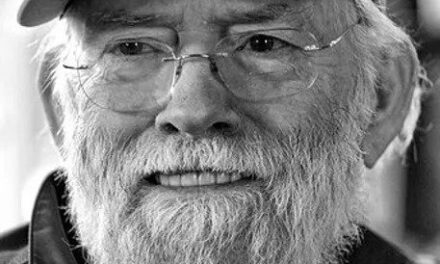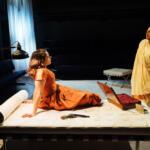Ihot Sinlay Cihek is a Taiwan-based Pangcah theatre artist whose work confronts the intersecting realities of Indigeneity, womanhood, and urban life. How Romantic: A Guide to Modern Pangcah Life follows a young woman struggling to readjust after returning from the city, and The Knife tells the story of a Pangcah woman who, out of love for her late grandfather, breaks a taboo by stealing a hunting knife. These two comedic solo performances marked a major breakthrough in her career, with the former earning her a nomination for the 2022/23 Taishin Arts Awards.
This year at the Prologue New Play Festival, Ihot Sinlay Cihek is set to steal the spotlight with her latest work, Neo-Ilisin. As in her previous pieces, Indigenous women navigating urban life take center stage, but this time she explores dialogues within Indigenous communities by bringing women from two different Indigeous groups—one Pangcah and the other Atayal—together onstage. After she completed the writing phase, Kuan-Ting Lin, Literary Manager at the Prologue Center for New Plays, caught up with her to talk about her new comedic two-hander and her views on mythologies, Indigeneity, and playwriting.
Lin: Would you like to share how your new play, Neo-Ilisin, came about?
Ihot: I don’t remember exactly when the inspiration hit me, but Neo-Ilisin actually started as a collaboration between Sayun Nomin and me for the 2020 Pulima Performing Arts Awards. We created a ten-minute piece titled Myths and Jokes, which explored how we, as Indigenous people living in the 21st century, perceive our mythologies.
After my nomination for the Taishin Arts Awards in 2023, the committee provided a development grant for one of my future projects, so I decided to expand Myths and Jokes into Neo-Ilisin. However, I’m a multitasker who’s always juggling deadlines, so the revision wasn’t completed until this September.
Lin: That explains why you include Indigenous mythologies in Neo-Ilisin. What is your own view of them?
Ihot: Mythologies give me complicated feelings. It depends on the story and which Indigenous group it comes from.
One of the tales in Neo-Ilisin belongs to the Pangcah people. It goes like this: Tiyamacan is a girl who shines. Her light is so bright that it attracts the son of the sea god, Felalakas. Felalakas proposes to her and promises to return for her in five days. However, Tiyamacan’s family does not consent to the marriage. They try everything to dim her light, but to no avail. Five days later, Felalakas raises a huge tidal wave to bring Tiyamacan to him, but it also tears apart her family, scattering them across the land. The tale later became the origin story of Tafalong, the Pangcah village where I was born and raised.
Still, I don’t quite believe in the story. Compared with other female figures in Pangcah mythology, Tiyamacan is too passive, and her tale reminds me of The Tale of the Bamboo Cutter from Japan. I suspect that this episode was added to the Pangcah oral tradition during the Japanese colonial period. Perhaps, facing the threat of armed colonizers, my ancestors retold a Japanese story, choosing gentler, more compliant heroines as a form of survival. In that sense, we Pangcah people preserved ourselves not only through submission but through storytelling itself.
Lin: Besides Tiyamacan and Felalakas’ story, you also include an Atayal tale in the play. Would you tell us more about that?
Ihot: Myths and Jokes was a devised work by Sayun and me, and unlike me, Sayun is Atayal.
Although we come from different Indigenous groups, I remember she had similar mixed feelings toward another Atayal tale. Once upon a time, there was a giant named Halus, known for his enormous genitals. Whenever the river flooded, he would lend his body part as a bridge, and thanks to his kindness, the Atayal people were able to move and settle across the mountains, where several villages were formed.
Sayun found the tale ridiculous, but she asked me to imagine how hard it was for her to keep a straight face when listening to it. She and other villagers were gathered around a campfire as the chief told the story. It wasn’t an occasion for jokes.
Sayun made me realize that although I am Pangcah and she is Atayal, we, urban Indigenous people with higher education, share the same struggle in making sense of our myths. Believing them seems naive, but mocking them feels worse—it would be a betrayal of the cultures that raised us. Because this sense of ambivalence is shared across Indigenous communities, I thought including another Atayal tale and multiple perspectives could better portray this sense of helplessness.

Ihot Sinlay Cihek’s The Knife. Staged reading at the 2024 Prologue New Play Festival. Photo by Aaron Liau.
Lin: Neo-Ilisin is driven by dialogues between a Pangcah and an Atayal character, Kating and Sayun, who have little understanding of each other’s cultural codes. What made you want to explore unfamiliarity within Indigenous communities?
Ihot: I’m fascinated by how Indigenous people form and break alliances so naturally.
Many Indigenous artists, including me, have a habit of scanning the room on the first day of rehearsal. If we’re lucky enough to find another Indigenous person, we bond almost instantly, as if we’ve known each other forever. But when I once visited Sayun’s village for research, the Atayal villagers were so indifferent to me, even after learning that I was Pangcah. It wasn’t until I introduced myself as a catechumen at a chapel that they began to warm up.
It dawned on me that invoking Indigeneity as a way to make friends is a survival strategy in a Han-dominated society, but it no longer works where Indigenous people are the majority. Living under the umbrella term “Indigenous” while not really knowing one another is both perplexing and fascinating to me, and it drives me to measure the distance between different Indigenous groups.
Lin: Sayun’s decision to join Kating’s restaging of a Pangcah harvest ceremony, or ilisin, seems like a gesture of alliance rather than isolation. What are your thoughts on friendships across Indigenous communities?
Ihot: I see such friendships as a form of preservation. Let me borrow two concepts from Taiwanese literature: “vertical inheritance” and “horizontal transplantation.”
Many Indigenous groups encounter difficulties tracing their histories. Much of our histories are passed down orally, and details are distorted or lost in transmission. At the same time, more Indigenous people today receive higher education, grounded in rationalism and science, so we are still figuring out how to respond to our histories and traditions. In this context, “vertical inheritance,” meaning to accept and embody what earlier generations passed down, becomes a real challenge.
Yet, it remains urgent for the Indigenous communities to preserve and thrive, and building friendships can be a way to do that. Sayun’s and my reactions to mythologies show that many Indigenous people feel burdened by traditional values, but that burden can also serve as a common ground to form alliances of resistance. When Indigenous people connect, we can turn dots into lines, forming a horizontal web that captures both our pain and our glory.
Lin: Your work often centers on characters caught between Western theories and traditional Indigenous values. Could you talk more about this tension?
Ihot: I remember during Taiwan’s debate over same-sex marriage, queer theory suddenly felt useless to me. The so-called “Age of Discovery” had interwoven Christianity with Indigenous cultures, so for religious reasons, many elders opposed same-sex marriage. The younger generation, including me, didn’t know how to respond. If we took the opposite stance, would that mean we were rejecting the cultures that raised us?
This experience shows why it’s difficult for educated Indigenous people to initiate change. Western theories are too idealistic and progressive. They distinguish good from bad and rush toward a better future, but that’s not how things are valued in traditional Indigenous cultures. So, when I’m in Taipei, I’m an educated woman; when I’m in Tafalong, Hualien, I’m a Pangcah person. It has always been an either-or situation for me.
Lin: I’d like to end with a question about your writing style. I noticed that your stage directions have a very poetic quality. Is that an artistic choice or an intuitive one?
Ihot: I’ve never noticed that, so it must be intuitive. Still, I think stage directions are like a line of flight from dialogues, which are very conventional in straight plays. When writing stage directions, I can step away from the sarcasm and humor that define my plays and be more honest with myself.
Lin: That’s all for today’s interview. Again, congratulations on Neo-Ilisin.
(Kuan-Ting Lin is a Taiwan-based translator, dramaturg, and playwright. Currently, he serves as the literary manager at the Prologue Center for New Plays.)

Ihot Sinlay Cihek’s The Knife. Staged reading at Datong Theatre Theater, Hualien, in 2023. Photo by Chien-Yu Liu.
This post was written by the author in their personal capacity.The opinions expressed in this article are the author’s own and do not reflect the view of The Theatre Times, their staff or collaborators.
This post was written by Kuan-Ting Lin.
The views expressed here belong to the author and do not necessarily reflect our views and opinions.


















